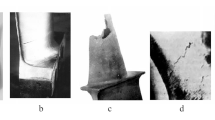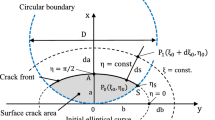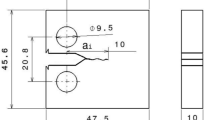Abstract
This paper describes the crack-growth predictions made in an AGARD Structures and Materials Panel, Engine Disc Cooperative Programme [1, 2] using the life-prediction code FASTRAN II. The objective of the program was to compare various methods of modeling crack-growth behavior in engine disc materials. The experimental database included three titanium alloys (Ti-6A1-4V, IMI-685 and Ti-17) and two crack configurations (compact and corner-crack tension). Crack-growth-rate data were provided under constant-amplitude loading (R=0.1 and 0.7) and under a repeated spike overload sequence. Participants were to use these data and mechanical properties of the materials to determine the crack-growth-rate properties to be used in their analysis method. The crack-growth properties were then used to predict the number of cycles required to grow a crack from an initial size to a final size under three simple variable-amplitude load sequences and under four complex Turbistan sequences. Predicted results from FASTRAN II agreed well with the test data with an overall mean of 1.01 and standard deviation of 0.31 for all materials and loading conditions.
Similar content being viewed by others
References
M.D. Raizenne, AGARD SMP Sub-Committee 33 Engine Disc Test Programme Fatigue Crack Growth Rate Data and Modelling Cases for Ti-6A1–4V, IMI-685 and Ti-17, National Research Council of Canada, Institute of Aerospace Research, LTR-ST-1785, Nov. 1990.
A.J.A. Mom and M.D. Raizenne, AGARD Engine Disc Cooperative Test Programme, AGARD Report No. 766, 1988 and AGARD Report No. 766 (Addendum), April 1993.
FASTRAN — Fatigue Crack Growth Analysis of Structures — A Closure Model, Computer Software Management and Information Center, University of Georgia, Athens, Georgia, December 1984.
J.C. Newman, Jr., A crack-closure model for predicting fatigue crack growth under aircraft spectrum loading, Methods and Models for Predicting Fatigue Crack Growth under Random Loading, ASTM STP 748 (1981) 53–84.
J.C. Newman, Jr., Prediction of fatigue crack growth under variable amplitude and spectrum loading using a closure model, Design of Fatigue and Fracture Resistant Structures, ASTM STP 761 (1982) 255–277.
J.C. NewmanJr., A crack opening stress equation for fatigue crack growth, International Journal of Fracture 24 (1984) R131-R135.
A.A. ten Have, Cold Turbistan — Final Definition of a Standardized Fatigue Test Loading Sequence for Tactical Aircraft Cold Section Engine Disc, Nationaal Lucht-en Ruimtevaartlaboratorium, NLR TR 87054 L (1987).
W. Elber, The significance of fatigue crack closure, damage tolerance in aircraft structures, in ASTM STP 486 (1971) 230–242.
D.S. Dugdale, Yielding of steel sheets containing slits, Journal of Mechanics and Physics of Solids 8(2) (1960) 100–104.
G.R. Irwin, Plastic zone near a crack and fracture toughness, Proceedings of the 7th Sagmore Conference (1960) IV.63–IV.74.
J.C. NewmanJr., C.C. PoeJr. and D.S. Dawicke, Proof test and fatigue crack growth modeling on 2024-T3 aluminum alloy, Proceedings of the Fourth International Conference on Fatigue and Fatigue Thresholds, Vol. IV (1990) 2407–2416.
R.G. Forman, V. Shivakumar, J.C. Newman, Jr., S.M. Piotrowski and L.C. Williams, Development of the NASA FLAGRO computer program, Fracture Mechanics: Eighteenth Symposium, ASTM STP 945 (1988) 781–803.
J.C. Newman, Jr., Discussion on cyclic crack growth transitional behavior, in Fatigue Crack Propagation, ASTM STP 415 (1967) 380–383.
J.C. Newman, Jr., Effects of constraint on crack growth under aircraft spectrum loading, in Fatigue of Aircraft Materials, A. Beukers, T. deJong, J. Sinke, A. Vlot and L.B. Vogelesang (eds.), Delft University Press (1992).
J.C. Newman, Jr., M.H. Swain and E.P. Phillips, An assessment of the small-crack effect for 2024-T3 aluminum alloy, in Small Fatigue Cracks, R.O. Ritchie and J. Lankford (eds.), Metallurgical Society of AIME (1986).
B.E. Powell and I. Henderson, The Conjoint Action of High and Low Cycle Fatigue, AFWAL-TR-83–4119, November 1983.
M.A. Hicks, R.H. Jeal and C.J. Beevers, Slow fatigue crack growth and threshold behaviour in IMI 685, Fatigue of Engineering Materials and Structures 6(1) (1983) 51–65.
Author information
Authors and Affiliations
Rights and permissions
About this article
Cite this article
Newman, J.C. Application of a closure model to predict crack growth in three engine disc materials. Int J Fract 80, 193–218 (1996). https://doi.org/10.1007/BF00012669
Received:
Accepted:
Published:
Issue Date:
DOI: https://doi.org/10.1007/BF00012669




